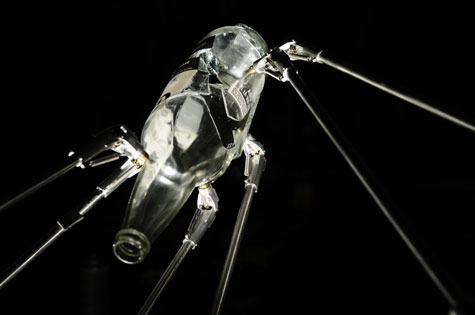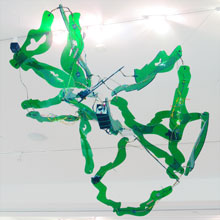
RECYCLING Schipper’s Measuring Angst (detail). |
Jonathan Schipper's Measuring Angst (2009) might be a complicated machine built to help you ponder whether your life would be better if you could take back the stupid thing you did last night.
The device is a curved armature holding together a shattered Corona bottle. The contraption dangles from wires beneath two metal tracks on the ceiling of Brown University's Bell Gallery in the exhibit "Nostalgia Machines" (64 College Street, Providence, through February 19). It slowly spins end over end as it glides toward the wall.
About a foot from the wall, the machine pauses. Metal arms break apart the bottle and slowly rotate the individual pieces. Then it brings them back together, as if making the bottle whole again, and spins back away from the wall to begin the cycle again. The effect is entrancing, like The Matrix "bullet time" slow-motion if the movie special effect was transformed into bunraku puppetry by robots.
The effect of the slowed-down, repeated action is like a memory that keeps replaying in our minds. Note the language: replaying. It's the language of video used as a metaphor for how our minds work. Curator Maya Allison's premise in "Nostalgia Machines" is that machines, which often seem focused on the future, can also tap their capacity for storing memory to help us remember and reconsider the past.
Measuring Angst is an elaborate contraption for imaging hurling a bottle at a wall and watching it shatter. And then realizing it was a mistake and wishing you could take it back. Or maybe Measuring Angst is a device for imaging how different your life would be if only you'd thrown that bottle. Or maybe, if we take a philosophical step back, it's built for contemplating the consequences of anything we do or don't, and whether it can be reversed.

ABSTRACT MEMORIES Pingree’s Umbrella Torque. |
The other artworks in "Nostalgia Machines" don't achieve this level of psychological charge or intriguing motion. How memories might be suspect is a theme of Jasper Rigole's Outnumbered (2009), a brief history of imposture. A crisp narrator describes various frauds and impostors as the screen pans to photos of various boys. The narrator seems to identify the boys as the perpetrators, but they're actually random heads a camera hidden around the corner is finding in a large, antique, school photo mounted on the wall.Zimoun's 150 prepared dc-motors, filler wire 1.0mm (2009/2010) offers 150 small round motors mounted in a line along the wall and each dangling a metal wire tail. When turned on, the wires make a rhythmic clanging that might bring to mind rain or might just sound irritating. Gregory Witt's Packing Tape (2010) sits on the floor waving a computer speaker in sync with sound of packing tape being pulled off a roll. The robot pantomime had a charming doggieness about it. The sound is apparently meant to call up memories of moving, but it reminded me of shipping work I used to do. Like Schipper's bottle contraption, how much we get out of it depends on how much the analogies the art tries to make connect with us.